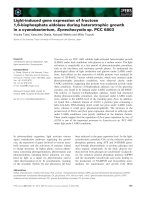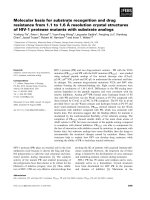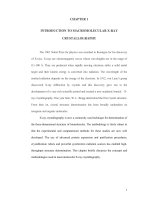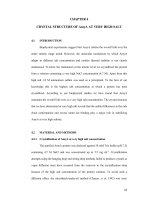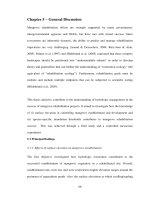1 1 6 animals of africa (expository nonfiction)
Bạn đang xem bản rút gọn của tài liệu. Xem và tải ngay bản đầy đủ của tài liệu tại đây (35.14 KB, 2 trang )
Animals of Africa
by Siobhan Phillips
ELL Reader 1.1.6
Expository Nonfiction
INTRODUCE THE BOOK
RESPOND
Activate Prior Knowledge/Build
Background Read the title, and point out
Africa on a map or a globe. Ask: Have you ever
seen pictures of animals that live in Africa? What
animals have you seen? Tell children this book is
about animals that live in Africa.
Answers to the Reader’s Inside Back Cover:
Preview/Use Text Features Preview the
reader by talking about the photographs together
and naming the labeled items.
Preteach Vocabulary Review the highfrequency words that appear in this book:
home, into, many, and them. Introduce
these key words from the book: Africa (p.1),
roar (p. 4), and floppy (p. 7). Discuss these
words and add them to a Word Wall.
READ THE BOOK
Choose among these options for reading to
support children at all English proficiency levels.
Read Aloud Read the book aloud as children
follow along. Pause to verify comprehension and
to explain unfamiliar concepts.
Monitored Reading Have children read
aloud a few pages at a time. Use the following
questions to support comprehension:
• Page 2 Where do the animals in the
photographs live? (They live in Africa.)
• Page 3 What does a zebra look like? (It
has black and white stripes.)
• Page 4 What sound does a lion make?
(A lion roars.)
• Page 5 What kind of bird lives in Africa?
(An ostrich lives in Africa.)
• Pages 6–8 What other animals live in
Africa? (Hippos, elephants, and giraffes live
in Africa.)
Talk About It
1. Possible response: Zebras live in Africa. They
have black and white stripes. They eat grass.
2. Possible response: Ostriches are too heavy to
fly. (Cause and Effect)
Write About It
Support writers at various English proficiency
levels.
Beginning Allow children to tell about their
animal in the home language. If feasible, have
children translate their work with the help of
a partner.
Intermediate Brainstorm a list of words
children can use when telling about their
favorite animal.
Advanced Have children act out their animal
and then say three or four sentences about it.
Extend Language The missing words are
zebra and hippo.
Answers to page 12:
Pages 2–3: A zebra eats grass.
Pages 4–5: A lion is a cat.
Pages 6–8: An elephant has a long trunk.
Family Link Read aloud the Family Link activity
on page 12 before sending copies of the Study
Guide home with children. Later, have children
share stories about African animals.
© Scott Foresman 1
Reread Have children reread the book with a
partner, in small groups, or independently. Have
them complete the Study Guide on page 12.
ELL Readers Teaching Guide
Unit 1, Week 6 Animals of Africa
11
Study Guide
Animals of Africa
Name
• Read Animals of Africa again.
• Answer the questions.
Pages
Question
2–3
What does a zebra eat?
4–5
Which animal is a cat?
6–8
Which animal has a long
trunk?
Answer
Family Link
© Scott Foresman 1
Ask family members to tell a story they know about
an African animal.
12
Animals of Africa Unit 1, Week 6
ELL Readers Teaching Guide
